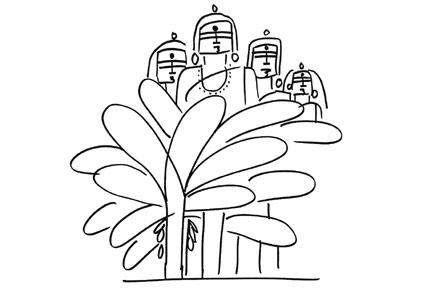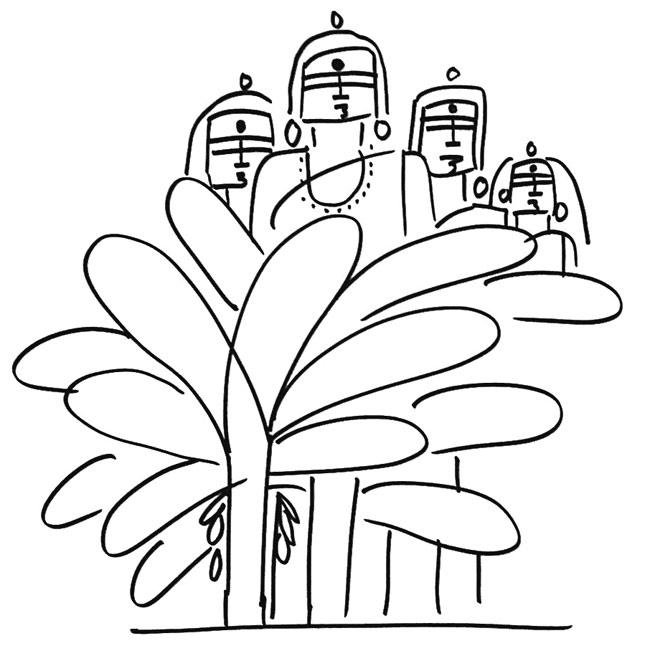In Indian folklore, there is frequent reference to kadali-vana or the plantain grove where bananas grow.

Illustration/ Devdutt pattanaik
 In Indian folklore, there is frequent reference to kadali-vana or the plantain grove where bananas grow. No one knows where this place exists. Some say it exists in the midst of southern forests. Others say it exists in the valleys of the Himalayas. And then there are those who say it exists in the imagination of poets and sages. Why is it so important? Because it refers to a land exclusive to women, a land which no man can enter.
In Indian folklore, there is frequent reference to kadali-vana or the plantain grove where bananas grow. No one knows where this place exists. Some say it exists in the midst of southern forests. Others say it exists in the valleys of the Himalayas. And then there are those who say it exists in the imagination of poets and sages. Why is it so important? Because it refers to a land exclusive to women, a land which no man can enter.

Illustration/ Devdutt pattanaik
ADVERTISEMENT
The story goes that there was once a princess (variously named as Pramila or Kamala) who one day saw a gandharva flying overhead. She noticed his genitals and burst out laughing. The gandharva cursed her that she and the other women of the palace who joined her in making fun of him would get locked in an orchard where no man would ever be able to enter. This was the kadali-vana.
Why banana? One can say that the fruit with its phallic shape was meant to taunt the princess who longed for, but was forever deprived of male companionship. Or one can say that it is a metaphor for women’s thighs which has long been compared in Sanskrit literature to the stem of the banana plant. Also, since banana is said to self-fertilise itself it has long been associated with the Mother Goddess who as Parvati created Vinayaka without (vina) needing a man (nayaka).
In the folklore of the Nath-Sampradaya, it is said that Matsyendranath got trapped in the kadali-vana, a metaphor getting ensnared by worldly sensuality until he was rescued by his able student Gorakhnath. Matsyendranath and Gorakhnath could enter this enchanted grove because they had siddha, magical powers acquired through celibacy. But while Matsyendranath entered, he did not leave. It took Gorakhnath’s intervention to pull him out.
In another tradition, Hanuman’s abode happens to be the kadali-vana. The story goes that the frustrated women of Stri-rajya, as kadali-vana is sometimes referred to, begged the Mother Goddess to grant them children. So Sita sent Hanuman to kadali-vana. She did this because she wanted to get Hanuman out of Ayodhya so that she could spend some time with Ram alone. She ordered Hanuman not to return until he gave those poor women children. Hanuman, who had taken the vow of celibacy (brahmacharya-vrat), did not know what to do. He entered the plantain grove and began singing songs in praise of Ram. His voice was so potent that hearing it the women inside kadali-vana became pregnant. But motherhood was not enough to satisfy the women. They wanted physical intimacy. And so Hanuman promised them that he would send a suitable man to them. That man was Matsyendranath.
In folk Mahabharatas, when the horse of the Pandavas enters this kadali-vana it turns into a mare. Arjuna is sent to fetch it but Pramila/Kamala refuses unless Arjuna agrees to marry her. He does and in satisfaction she returns the mare to the Pandavas.
The author is Chief Belief Officer of the Future Group, and can be reached atdevdutt@devdutt.com
The views expressed in this column are the individual’s and don’t represent those of the paper.
 Subscribe today by clicking the link and stay updated with the latest news!" Click here!
Subscribe today by clicking the link and stay updated with the latest news!" Click here!







